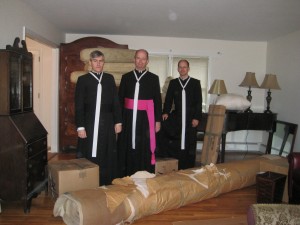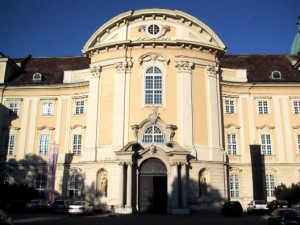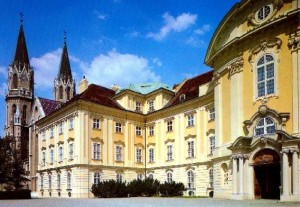Canons Offer New Way of Life for American Priests, Part One

Fr. Elias Carr, Fr. Daniel Nash, and Fr. Bruno Semple of the Canons Regular of St. Augustine just landed in New York. They took a break from unpacking for this exclusive interview.
The Canons Regular of St. Augustine, a group of priests who live in community and serve parishes, recently landed in Long Island, New York. Their blend of community life and diocesan ministry is ancient, but a first for the U.S. The Order’s new American foundation, the Canonry of St. Leopold, offers fresh possibilities for U.S. priests and represents a push for renewel and reform.
I learned about the Canons through Fr. Elias Carr, whom I met at a suburban parish about ten years ago. When he decided to uproot and join the Canons in Klosterneuburg, Austria, I visited their 900 year old abbey on a group pilgrimage. While the storied abbey was breathtaking, their perspective on community life also made a lasting impression on me.
The Canonry of St. Leopold currently consists of three American priests. Fr. Daniel Nash is Prior of the Canonry and Pastor of St. Patrick Catholic Church in Glen Cove, New York. Fr. Bruno Semple is Associate Pastor (aka Parochial Vicor) at St. Patrick’s. Fr. Elias Carr is Pastor of St. Rocco Catholic Church in the same town.
All three graciously agreed to take a break from unpacking boxes and assembling furniture to discuss the American Project in an exclusive, two-part interview.
Q: You started out as American priests. How did you discover the Canons Regular of St. Augustine?
Fr. Daniel: I visited Klosterneuburg with Fr. Clemens (formerly Timothy) Galban in 1989. We all take new names upon entering the community. Fr. Clemens had a great interest in canonical life and the history of canons. He wrote to many abbeys in Europe, but none bothered to respond except for Klosterneuburg.
At that time, though deeply impressed by the grandeur of the House and its history, I never seriously considered entering: the life was too alien.
In 1990, however, I entered the Archdiocese of Washington, together with Fr. Clemens. I visited Klosterneuburg again in 1996, while a seminarian at the North American College in Rome. I brought Fr. Elias and Fr. Bruno with me, then also seminarians, though the visit was not really vocational in nature. Although intrigued by the life of such an old institution and having always had a great respect for religious life, I was completely focused on being ordained a priest for the Archdiocese of Washington.
Fr. Elias: I learned about the Canons at the Abbey of Klosterneuburg (“Stift Klosterneuburg”) through Fr. Clemens. I first visited there as a seminarian in 1996 over Christmas holiday with the future Fr. Daniel, Fr. Bruno and two other seminarians. At that time, none of us had any idea that the Abbey would play such an important role in our lives. It was a cold, dark, exotic jumble of buildings with friendly Canons, who hosted us, especially Fr. Markus Eidsvig, who eventually became our novice master and is now the Bishop of Oslo, Norway.
Now go forward to 2001. Fr. Clemens and I were driving out to Delaware to visit Fr. Daniel (in those days Fr. Stephen Nash) and Fr. John Grimm. The long car ride turned to questions about the canonical life as a way of being a priest. During that conversation, I discerned the outlines of a canonical vocation. In the following weeks, we discussed the vocation further and inquired with Fr. Daniel about the wisdom of such a vocation. By the end of September 2001, we agreed to discern seriously whether this call was from God.
Fr. Bruno: I found the Canons through friends when I attended the North American College in Rome for two years. The seminarians in Rome customarily went on trips around Europe during breaks from school, often to religious houses like Benedictine monasteries. We went to Klosterneuburg for Christmas 1996.
Klosterneuburg was like nothing that I had ever seen before. I couldn’t quite wrap my mind around an order that lived in what looked like a monastic setting but still did primarily parish ministry. It was all very new to me and foreign. After the trip there was no mention of joining the Canons, but it made an impression.
We learned that an entire order can have community life and do pastoral work. Every now and again we might recall our time there and how nothing like that exists here in the States. But we were all diocesan priests for our respective dioceses. We weren’t really talking about doing anything like joining. Years later, that became something that we wanted and the discussions became more pointed, more serious.
Q: What made you want to uproot from your parish and join the Canons in Europe?
Fr. Daniel: It was only after a number of years as a priest serving in a few different parishes, which I thoroughly enjoyed, that I began to notice that something was missing. While I loved being a priest and involved in the life of a parish, there was a certain lack of continuity in life.
Fr. Elias: For many priests, their first assignment is an extraordinary experience of grace. I found that to be the case at Holy Spirit Catholic Church in Annandale, Va. The rectory was home to four priests. Our common life in the rectory was, by and large, good. However, I came to recognize that as a man, I needed more support. Celibacy need not be solitary. It can also be communal insofar as one’s total commitment to God can be lived out in the framework of a religious community.
The death of a recently-ordained priest, Fr. Scott Buchanan, a priest of Charleston, South Carolina, in January 2001; a diocesan priest retreat directed by Archabbot Lambert Reilly, O.S.B. in Spring 2001; the abuse crisis of early 2002; and a number of other signs urged me to conclude that the priesthood needed reform and I needed to pursue this call soon.
Fr. Bruno: I was ordained for the diocese of Spokane, WA. The diocese has very few parishes where priests live together. The vast majority live alone. Even some of the parishes with two priests have them live in separate apartment buildings rented by the parish. Out where I was, the priests in my region would get together once in a while to have lunch, but this would require driving 45-minutes one way to meet up. We were spread out geographically.
I missed the community life that I had as a seminarian and I didn’t see much hope in having that kind of life in my diocese. I saw that the Canons were able to still provide for a parish while keeping common prayer and meals: a common life. Finally, when my friends were doing this, it became something that was possible for me to do as well.
Q: Does living in community make a big difference as a priest?
Fr. Daniel: Yes and yes again! It is, I believe, the best of both worlds. We can be busy with all the wonderful duties of a priest, while knowing that there is always someone there, a brother, with whom to share it: the joys and the burdens. This is the great antidote to the loneliness and isolation which so often plague diocesan priests. Either they are actually alone, or the priests with whom they live and work have such a different background or training or outlook, that they never connect.
It’s also a remedy to the subtle danger of seeing one’s parish or ministry as a personal fiefdom. The Lord Jesus never sent any of his disciples out on a mission alone; the apostles lived together, holding all things in common. While there may be many reasons for the development of the structures of the diocesan priesthood as it is, a priest living and working alone is not the ideal.
Fr. Elias: Yes. For me, at least, it means that I have a family, not founded on the institution of marriage, but rather on religious vows. I share my life with other men who are committed to Jesus Christ, to the priesthood and to the Church. We have a life together. We pray together; we eat together; we relax together. We support one another on good days and on bad days. We forgive each other. The aim of this life is to share a common burden, namely, our priestly ministry, so that it can be lighter to bear.
Fr. Bruno: Yes, a lot. First, we are not just thrown together the way diocesan priests often are in a parish. Because we all belong to the same community of about 45 men, there is more opportunity to know the men in our “family.” We are connected to each other in a real way through our common life, especially in the four years leading up to solemn vows. There are so many different ways we support each other and enrich each other’s lives.
Since the men working together are connected and know each other, it’s possible to mold the mission around our individual strengths and weaknesses. It seems more human, less bureaucratic here.
Q: What is the Abbey in Klosterneuburg like? Those places seem like castles to Americans.
Fr. Daniel: It is. Well, it’s a palace, or was supposed to be. The Emperor Karl VI decided to make Klosterneuburg into an imperial residence (for which honor the Community got to pay, by the way), but his unexpected death put an end to that project. His daughter, the Empress Maria Theresia, didn’t want to have anything to do with this project (she built her own residence!). This left us with an uncompleted Baroque palace.
Klosterneuburg is certainly a grand place, a Baroque jewel with many medieval parts still intact. But, mostly, it was just home, where our family lived. The amusement of living in a Baroque palace does, after a while, wane a bit. Although the history of the House itself, almost 900 year old, was always fascinating, one can’t always be a tourist.
Fr. Elias: The Abbey is old and it has endured. It has survived fires, a dearth of vocations, social turmoil, wars and a host of challenges. The Abbey gives the community a sense of constancy and perseverance. It has the solidity and confidence of an institution that has endured over centuries.
The greatest treasure of the Abbey is the community, which has served God through prayer and pastoral work for centuries. This Abbey is like a small diocese. It administers twenty-four parishes, most of which are staffed by Canons. It has also taken on the pastoral care of the third largest parish in Norway, St. Paul in Bergen.
Fr. Bruno: The Abbey is indeed partially a palace built as a residence for the Austrian Kaiser, who never used it. That wing is still kept as a museum. The other parts are still built up like a castle. The oldest part is where men live when they are new members. The foundation and walls are from the 12th century.
It is a bit odd to think that my bedroom door could be 200 years old. But after a while, it all blends into the background. Life has to be lived and you can’t be impressed to death every day. But, there were some things that were not part of my daily life, like the museum. When I gave tours to guests, I would still be overwhelemed by some of the pieces, especially the Archducal Crown of Austria.
Q: Was the move from the U.S. to Austria an easy adjustment?
Fr. Daniel: On the whole, at least for me, yes. There is no better exercise in humility than having to learn and speak a new language, and the cultural differences and challenges were considerable. Having lived abroad previously, I found it somewhat easier to adjust that some others did. And living in a Baroque palace didn’t hurt. In the end, however, what made the adjustment possible was the vision of living together in a family.
Fr. Elias: Hardly. I found the Church in Austria difficult to understand. It was very different from the Church I had known and loved in Virginia. Added to this was the fact that the pastoral work was entirely in German. The beginning was a purification and a trial.
After two years, I was assigned to our community in Bergen, Norway, where I served for two happy years. The Church in Norway was more familiar to me insofar as it was a minority church in a formerly Protestant society. It was dynamic and I enjoyed many interesting pastoral experiences in Norway. What it lacked, though, was a proper common life since our numbers were too few to pray the Liturgy of the Hours together throughout day.
Fr. Bruno: A new country, language, daily schedule, people…the adjustment took a while. The people there have a different upbringing. I don’t want to generalize specific traits because everybody is an individual and won’t fit my description. But, I had a very hard time knowing what people were thinking. I had a hard time learning to anticipate how people would recieve things that I said. It’s hard enough to communicate effectively in your language and neighborhood. Austria was much more difficult.
Q: As a priest in Austria, what was your daily life like?
Fr. Daniel: Priests in Austria are not addressed as “Father.” [Instead the honorific “Dom” is used.] That, perhaps, expresses the defining difference between my experience as a priest in the States (and elsewhere) and my experience in Austria. This causes, I believe, something of a crisis for priests, especially American priests working in Austria.
Spiritual fatherhood constitutes a fundemental element of priestly identity. The moment someone addresses me as “Father,” even if we are going to have a difficult or conflict-filled conversation, we have made one thing clear: we are part of the same family. And the priest, being reminded of the obligations of his fatherhood, should then proceed in respect to that role. The closeness which I have so often felt with the faithful was almost wholly absent in Austria.
Also, few people go to church, given the system (instituted by Hitler) of the church tax (euphemistically called a “donation”). What it means to “belong” to the Church in Austria, in the minds of most people, is almost incomprehensible to Americans, and it took a long time before I began to understand, still imperfectly, what that meant.
Mass attendance in Vienna is abysmal. Almost no one ever goes to confession. To be a priest without regularly hearing confessions is a great trial and a great impoverishment, both for priest and people. Although Austria is a land of many beautiful churches, they serve, sadly, mostly to provide a patina of religion over a deeply secular society.
Stay tuned for Part Two tomorrow to learn about their return to the U.S. and how you can support their mission.



